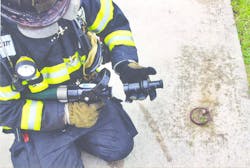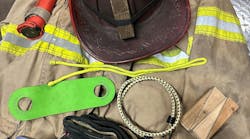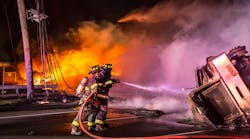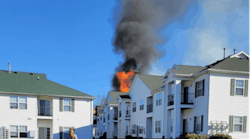I’ve been involved in fire service training and education for more than two decades and have seen many promising innovations come and go. But few technologies have represented as significant a step forward as Class A foam and compressed air foam systems (CAFS). The technology’s roots are in wildland fire operations, but it has proved to be a revolutionary breakthrough in structural firefighting.
Compressed air foam technology causes a significant amount of controversy in the fire service. Not since the debate over which is the “best” nozzle, a smoothbore or a variable pattern, have we seen so many opinions regarding the use of technology. The pro- and anti-CAFS camps can both explain their positions – why the technology does or does not work and how it improves or reduces firefighter safety. Both camps are correct. While the appropriate use of CAFS has dramatic positive effects, the reality is that undertrained departments struggle and fail to reap benefits after trial-and-error foam applications.
As with many emerging fire service technologies, there is a good deal of misinformation on CAFS application for structural fire suppression. Advances in CAFS apparatus design make it suitable for structural firefighting, but the fire service’s ongoing challenge is to provide widespread access to effective training and education on fireground foam application strategy and tactics.
For nearly 25 years, I have been an end user and fire instructor, conducting hundreds of fire attacks and developing CAFS strategy and tactics for structural fire suppression. These live-fire-training and test evolutions, conducted in acquired structures, have ranged from residential room-and-contents fires to fully involved large commercial occupancies. Compressed air foam has been applied via exterior, transitional and aggressive interior fire attack.
Developing effective compressed air foam application has been an iterative process spanning many days, nights and weekends. As attack line instructor, I led crews down dark, hot hallways under severe fire conditions, resulting in instant feedback on what works and what doesn’t. This feedback led to continuous improvement in strategy and tactics, and development of foam application best practices. These practices have been documented and delivered at onsite departmental training sessions across the United States and Canada, and will soon be available in an online eLearning program.
Of the many compressed air foam application best practices, the following five should be top-of-mind for every fire officer whose department uses CAFS for structural fire attacks.
Best practice 1. Match the compressed air foam delivery rate to the fire challenge.
Since CAFS has roots in low-flow wildland firefighting apparatus, the use of low delivery rate has carried over into structural firefighting. This is a dangerous practice that must cease.
We’ve all heard that death and taxes are the only guarantees in life. I’d like to add a third: Inadequate compressed air foam delivery rate will cause excessive structural fire loss and compromise firefighter safety.
For example, I received a call from the chief of a small career department who had recently taken delivery of a CAFS-equipped structural pumper. He complained that firefighters had received burns through their turnout gear during live-fire training. When I asked the chief about foam delivery rate, he said that they had applied a 50-gpm/50-cfm delivery rate, with Class A foam concentrate injected at 0.5% through 1¾-inch attack hose.
The choice of delivery rate was strange, because prior to CAFS, the department’s standard operating procedure (SOP) was water delivery at 130 gpm with 1¾-inch hose. When I asked him why the delivery rate was significantly reduced with CAFS, he responded, “The technician from the apparatus manufacturer who delivered the engine told us that’s how you use CAFS.” He then added, “Isn’t that correct? Aren’t you supposed to reduce delivery rate to save water when using CAFS?”
Absolutely not. Firefighters must remember that compressed air foam streams consist of water, foam concentrate and compressed air. The water extinguishes fire, and the air and foam concentrate ensure that the water delivery rate is more effective in stopping fire. Adequate gpm delivery is required to reach critical application rate for an effective fire stop and crew protection. I advised that he should consider delivering 130 gpm/65 cfm through the 1¾-inch attack hose. This provides a compressed air foam delivery rate comparable to what was used previously with water.
The objective of using CAFS is to leverage water supply to make water flow rates much more effective at stopping fire. It does not make sense to significantly reduce the liquid gpm delivery rate to capture CAFS benefits.
What about water savings using CAFS? If it’s applied at an effective delivery rate, compressed air foam reduces the time required for initial and sustained firefights, and overhaul. Nozzles remain open for a shorter period, reducing total gallons of water needed compared with water application alone.
In addition to the department’s problem of a too-low delivery rate, it was applying too-dry finished foam. A 50-gpm/50-cfm flow rate is a 1:1 ratio of gpm (liquid) and cfm (air), which produces a heavy, slow-draining finished foam. This is a poor consistency for flame knockdown and fuel cooling during direct fire attack. The suggested 130-gpm/65-cfm flow rate (a 1:0.5 ratio of liquid to air) produces runny, wet, quick-draining foam for optimum cooling.
Best practice 2. Evaluate and choose nozzles carefully – consider using smoothbore nozzles.
As a firefighting medium, compressed air foam behaves differently than water. Thoughts and practices on what is considered an optimal discharge device may need to change. Traditional fire service nozzles are designed from a hydraulic (water) flow standpoint, not from a hydraulic and pneumatic (compressed air foam) flow perspective.
The issue with delivering compressed air foam through legacy discharge devices is that nozzle aperture diameter (opening size) is designed for water application alone. Compressed air foam systems deliver foam solution (liquid) and air through nozzles, so nozzle diameters must increase to support delivery of both liquid and air.
As a compressed air foam discharge device for 1¾-inch attack hose, I prefer a quarter-turn pistol-grip ball valve with open butt. No nozzle is installed. The ball valve’s 1?-inch inside diameter bore becomes the nozzle orifice. The target delivery rate for initial fire attack through this device is 120 gpm/60 cfm. (See Figures 1, 2 and 3.)
Applying water alone through the quarter-turn ball valve shown in Figure 1 would be ineffective. The bore is too large to provide an effective fire stream from a 1¾-inch hoseline. However, when applying compressed air foam, it is an optimum discharge device with excellent stream reach and reduced nozzle reaction.
When using combination nozzles, internal nozzle passage restrictions cause degradation of high-quality compressed air finished foam. Note that there are no internal passage restrictions in the quarter-turn ball valve.
A department’s CAFS nozzle choice MUST be based on classroom instruction. Students must learn to identify target flow rate and understand the tradeoffs of each type of nozzle. Hands-on training using the nozzle choice under controlled live-fire conditions is essential.
Best practice 3. Take advantage of compressed air foam’s excellent stream reach for transitional or exterior fire attack.
Compressed air energy significantly propels foam streams for additional distance. A real benefit is high-energy stream reach and punch, providing foam delivery deep inside structures.
During evolutions using various structure types and sizes, compressed air foam has repeatedly been shown to be effective via application from the exterior. A real concern when applying any agent from the exterior, including compressed air foam, is the fire stream’s potential to push fire to uninvolved portions of the structure. Positive experience with CAFS shows fire immediately darkens with little impact on flame and combustion gas spread. If a significant volume of fire is knocked down from outside and conditions permit, crew entry becomes viable sooner.
Just because foam can be successfully applied from the exterior of structures, the use of CAFS does not invalidate the reasons a coordinated, aggressive interior fire attack may be best. Compressed air foam is very effective for the coordinated-aggressive interior fire attack.
Best practice 4. After achieving blackout during interior fire attack, continue compressed air foam application from the entry point before entering the fire compartment.
Compressed air foam is highly effective at ending the flame phase of combustion. Flame knockdown of a compartment involved in flashover occurs quickly. Entering firefighters could encounter an insufficiently cooled, untenable atmosphere.
During legacy water-only firefights, nozzle operators have been trained to immediately close nozzles at blackout to prevent water damage. This practice changes for compressed air foam application. To prevent crews from taking a beating due to insufficient cooling, continue applying foam to walls and room contents to provide additional cooling before entry.
How long should you apply additional foam before entry? A rule of thumb, developed and tested by the CAFS Institute, is to apply agent for the same length of time it takes to achieve flame darkening. If it takes 10 seconds for blackout, continue applying foam to surfaces for another 10 seconds before moving the crew inside.
During additional application, if foam collects on the floor and starts flowing back out and around the attack team, you’ve either applied it too long or have an obstruction preventing the hose stream from reaching the intended target.
Best practice 5. Conduct a compressed air foam strategy and tactics training program, open to all department members and delivered by a qualified training provider.
The benefit of compressed air foam, as with any new firefighting technology, is only as good as the firefighters’ knowledge of its detailed application, benefits and limitations. When used correctly, compressed air foam is not a panacea, but another valuable tool in the toolbox. It can significantly increase firefighter safety and reduce property loss.
As a senior instructor with the CAFS Institute, I conduct strategy and tactics programs across the country. Feedback from department members on foam application best practices has, in virtually every case, exceeded expectations and instilled the confidence they need to integrate the technology as standard operating procedure.
As a fire instructor, it’s a great feeling when you see department members begin to recognize, understand, and then accept the value of using CAFS for structural firefighting. These motivated individuals are key to the successful future of the fire service.
5
BEST PRACTICES FOR USING COMPRESSED
AIR FOAM IN STRUCTURAL FIREFIGHTING
1. Match the compressed air foam delivery rate to the fire challenge.
2. Evaluate and choose nozzles carefully – consider using smoothbore nozzles.
3. Take advantage of compressed air foam’s excellent stream reach for transitional or exterior fire attack.
4. After achieving blackout during interior fire attack, continue compressed air foam application from the entry point before entering the fire compartment.
5. Conduct a compressed air foam strategy and tactics training program, open to all department members and delivered by a qualified training provider.






